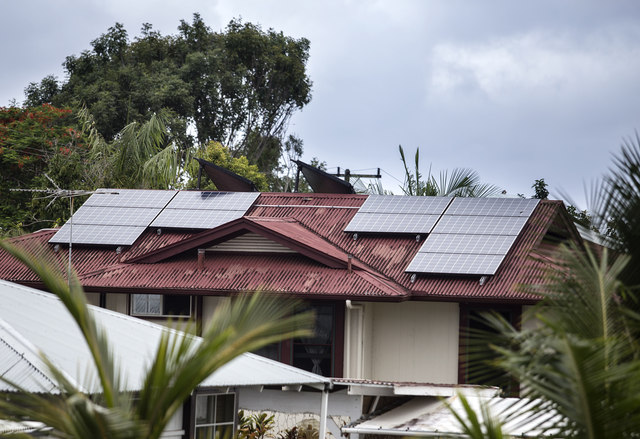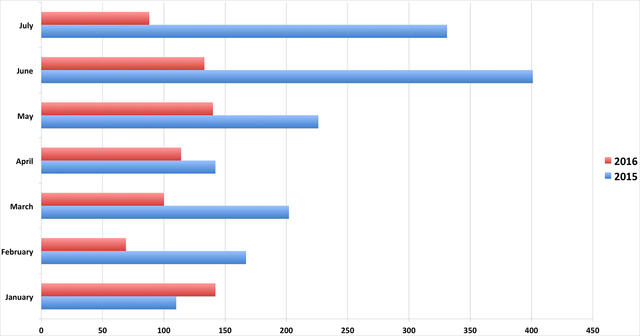The number of applications for photovoltaic systems in Hawaii County has dropped considerably from last year’s numbers, according to permit data from the county Department of Public Works. ADVERTISING The number of applications for photovoltaic systems in Hawaii County has
The number of applications for photovoltaic systems in Hawaii County has dropped considerably from last year’s numbers, according to permit data from the county Department of Public Works.
This year began on a strong note, with 32 more applications in January compared to January 2015, but they have steadily dropped from there. Last July, there were 331 permit applications filed with the county. This July, just 88.
“It’s not a trivial thing,” said Marco Mangelsdorf, president of Hilo-based ProVision Solar Inc. and member of Hawaii Island Energy Cooperative.
Mangelsdorf and other island solar panel installers attribute the shift to a Hawaii Public Utilities Commission decision last fall that ended the Net Energy Metering program for PV systems, replacing it with two new programs: Consumer Grid Supply and Consumer Self-Supply.
Under Net Energy Metering, customers on the Big Island hooked up to the Hawaii Electric Light Co. grid and were credited the full retail rate for any excess energy their solar systems produced. The program was in use 14 years.
Mangelsdorf said that adoption of solar systems was in the dozens per year from 2001-07, and began to “really accelerate” in 2007. There currently are more than 10,000 residential PV customers on Hawaii Island, or about 19 percent of single-family homes.
According to HELCO, almost 50 percent of the energy generated on the island in 2015 was from a renewable source.
“We’re still selling, but it’s a different conversation you have to have because you’re not getting full credit back for what you feed into the grid,” said Ed Harris, vice president of operations for P.A. Harris in Kona.
Consumer Grid Supply gives PV owners about 15 cents back for the energy they supply to the grid. Consumer Self-Supply pulls a home off the grid entirely, using battery storage to hold any excess solar power.
HELCO president Jay Ignacio said in a statement that solar investment also decreased because fuel oil prices dropped during the past year, leading to lower electricity bills.
“Generally, lower electric bills provide less of a financial incentive for customers to invest in rooftop solar because the return on their investment is longer,” he said.
To date, HELCO has received 500 applications for the CGS program, Ignacio said.
But even that program is fast approaching its end.
When it created the CGS and CSS programs, the PUC also set a capacity limit of 5 megawatts for Hawaii County, and as of Aug. 9, there were just 0.45 megawatts remaining. Maui County reached its limit in June.
After CGS reaches its limit, consumers who are interested in solar will rely on CSS.
“Despite what I’d like to see happen to my business — which is to continue — the bottom line right now is that the Customer Self-Supply option requires battery storage, and right now the options are quite limited … and they are expensive,” Mangelsdorf said. “So, I’m very much hoping that the commission will increase the cap to provide homeowners with more choices.”
“When the prices of batteries go down, that’s when more people will take advantage of that self-supply,” Harris said.
He said batteries currently cost anywhere from $200 to $1,000.
“In Hawaii in this industry, we are truly on the new frontier here, in that we are seeing limitations and challenges to rooftop solar … that is not being seen yet on the mainland,” Mangelsdorf said. “There are limitations as to what today’s grid can handle.”
Email Ivy Ashe at iashe@hawaiitribune-herald.com.





